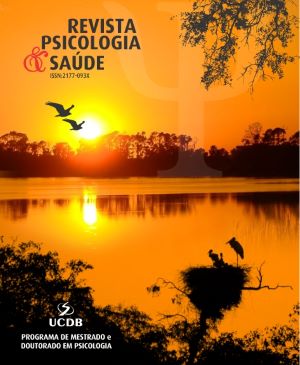Adolescence Well-Being: Role of the City and Community
DOI:
https://doi.org/10.20435/pssa.v13i1.1029Keywords:
adolescent, urban health, social participation, social welfareAbstract
Introduction: Adolescence well-being is a health issue that encompasses both physical and social context. Objective: To evaluate the contribution of social insertion in the city, perception of neighborhood quality and sense of community for the well-being of school adolescents. Methods: The study was carried out with 119 eighth grade students from Porto Alegre, Brazil, who were evaluated through a socio-demographic data inquiry, social inclusion to the city, sense of community, neighborhood quality perception and personal well-being. Multiple linear regression analysis was performed. Results: We identified a significant contribution of all evaluated constructs for well-being. Discussion: The high variance explained by the models obtained demonstrates the importance of the environment, both in terms of resources and socio-community relations, for the well-being of schoolchildren. Conclusions: Investing in the quality of urban contexts should be a social and political goal.
References
Amaro, J. P. (2007) Sentimento psicológico de comunidade: Uma revisão. Análise Psicológica, 1(XXV), 25-33. doi: http://dx.doi.org/10.14417/ap.427 DOI: https://doi.org/10.14417/ap.427
Assis, S. G., Avanci, J., & Oliveira, R. V. C. (2009). Desigualdades socioeconômicas e saúde mental infantil. Revista de Saúde Pública, 43(1), 92-10. doi:http://dx.doi.org/10.1590/S003489102009000800014 DOI: https://doi.org/10.1590/S0034-89102009000800014
Associação Brasileira de Empresas de Pesquisa. (2015). Critério de Classificação Econômica Brasil. ABEP. Disponível em http://www.abep.org/criterio-brasil.
Bonaiuto, M., Fornara, F., & Bonnes, M. (2003). Indexes of perceived residential environment quality and neighbourhood attachment in urban environments: a confirmation study on the city of Rome. Landscape and Urban Planning, 65(1-2), 41-52. doi: http://dx.doi.org/10.1016/s0169-2046(02)00236-0 DOI: https://doi.org/10.1016/S0169-2046(02)00236-0
Bonnes, M., Bonaiuto, M., Aiello, A., Perugini, M., & Ercolani, A. P. (1997). A transactional perspective on residential satisfaction. In C. Despres, D. Piché (Eds.), Housing Surveys: Advances in Theory and Methods (pp. 99-135). Quebec: Crad. DOI: https://doi.org/10.1037/t26335-000
Brasil. (2012). Resolução 466, de 12 de dezembro de 2012. Conselho Nacional de Saúde. Ministério da Saúde. Disponível em http://andromeda.ensp.fiocruz.br/etica/sites/default/files/documentos/Res%20466_2012
Bronfenbrenner, U. (1996). A Ecologia do desenvolvimento humano: Experimentos naturais e planejados. Porto Alegre: Artes Médicas.
Bronfenbrenner, U. (2011). A bioecologia do desenvolvimento humano: Tornando os seres humanos mais humanos. São Paulo: Artmed.
Buchmann, M., & Steinhoff, A. (2017). Social inequality, life course transitions, and adolescent development: Introduction to the special issue. Journal of Youth & Adolescence, 46(10), 2083-2091. doi:http://dx.doi.org/10.1007/s10964-017-0740-2 DOI: https://doi.org/10.1007/s10964-017-0740-2
Caiaffa, W. T., & Friche, A. A. (2012). Urbanization, globalization and road safety: A potential dialogue in search of equity? Ciências e Saúde, 17(9), 2238-2341. doi:http://dx.doi.org/10.1590/S1413-81232012000900004 DOI: https://doi.org/10.1590/S1413-81232012000900004
Casas, F. (2010). El bienestar personal: Su investigación en la infancia y la adolescencia. Encuentros en Psicología Social, 5(1), 85-101.
Chavis, D. M., Hogge, J. H., McMillan, D. W., & Wandersman, A. (1986). Sense of community Brunswick’s lens: A first look. Journal of Community Psychology, 14(1), 24-40. doi: http://dx.doi.org/10.1002/1520-6629(198601)14:1<24::AID-JCOP2290140104>3.0.CO;2-P DOI: https://doi.org/10.1002/1520-6629(198601)14:1<24::AID-JCOP2290140104>3.0.CO;2-P
Chiessi, M., Cicognani, E., & Sonn, C. (2010). Assessing Sense of Community on adolescents: Validating the brief scale of Sense of Community in adolescents (SOC-A). Journal of Community Psychology, 38(3), 276-292. doi:http://dx.doi.org/10.1002/jcop.20364 DOI: https://doi.org/10.1002/jcop.20364
Elvas, S., & Moniz, M. (2010). Sentimento de comunidade, qualidade e satisfação de vida. Análise Psicológica, 28(3), 451-464. doi:http://dx.doi.org/10.14417/ap.312 DOI: https://doi.org/10.14417/ap.312
Farias, T. M., & Pinheiro, J. Q. (2013). Vivendo a vizinhança: Interfaces pessoa-ambiente na produção de vizinhanças “vivas”. Psicologia em Estudo, Maringá, 18(1), 27-36. doi:http://dx.doi.org/10.1590/S1413-73722013000100004 DOI: https://doi.org/10.1590/S1413-73722013000100004
Field, A. (2009). Discovering Statistics Using SPSS (3a ed.). London: Sage Publications Ltd.
Fierro, A., & Rando, B. (2007). Escalas Eudemon de Bien-Estar Personal: Características psicométricas. Anuario de Psicología, 38(3), 401-412. Disponível em https://psycnet.apa.org/record/2008-02576-003
Figueiredo, G., L. A., Martins, C. H. G., Damasceno, J. L., Castro, G. G., Mainegra, A. M., & Akerman, M. (2017). Direito à cidade, direito à saúde: quais interconexões? Ciências e Saúde Coletiva, 22(12), 3821-3830. doi:http://dx.doi.org/10.1590/1413-812320172212.25202017 DOI: https://doi.org/10.1590/1413-812320172212.25202017
Glick, G. C., & Rose, A. J. (2011). Prospective associations between friendship adjustment and social strategies: Friendship as a context for building social skills. Developmental Psychology, 47, 1117-1132. doi:http://dx.doi.org/10.1037/a0023277 DOI: https://doi.org/10.1037/a0023277
Instituto Brasileiro de Geografia e Estatística. (2010). Censo demográfico 2010. Rio de Janeiro: IBGE. Disponível em https://cidades.ibge.gov.br/brasil/rs/porto-alegre/panorama
International Test Commission (2016). ITC guidelines for translating and adapting tests (Second edition). Versão 2.4. Disponível em https://www.intestcom.org/files/guideline_test_adaptation_2ed.pdf
Kelly, J. G., & Hess, R. E. (1986). The ecology of prevention: Illustrating mental health consultation. New York: The Haworth Press.
Lefebvre, H. (2011). O direito à cidade. São Paulo: Centauro.
Leite, M., & Silva de Melo, M. (2017). Juventudes e espaço urbano: uma análise geográfica na cidade d Montes Claros-MG / Youths and urban space: a geographical analysis in the city of Montes Claros-MG. Caderno de Geografia, 27(48), 123-141. doi:http://dx.doi.org/10.5752/p.2318-2962.2017v27n48p123 DOI: https://doi.org/10.5752/P.2318-2962.2017v27n48p123
Martinez, M., Black, M., & Starr, R. (2001). Factorial structure of the Perceived Neighborhood Scale (PNS): A test of longitudinal invariance. Journal of Community Psychology, 30(1), 23-43. doi:http://dx.doi.org/10.1002/jcop.1048 DOI: https://doi.org/10.1002/jcop.1048
Meireles, A. L., Xavier, C. C., Cortes, M. G., Moulin, Z. S., & Caiaffa, W. T. (2013). Bem-estar da criança e do adolescente: Um construto multidimensional. Revista Medicina Minas Gerais, 23(2),138-14. doi:http://dx.doi.org/10.5935/2238-3182.20130023 DOI: https://doi.org/10.5935/2238-3182.20130023
Pardo-Merino, A. & Ruiz-Díaz, M. (2002). SPSS 11: Guia para el análisis de datos. Madrid: McGraw-Hill.
Patrão, B. V. L. G. (2009). O direito à convivência comunitária da criança e do adolescente no contexto urbano: o município e o ministério das cidades na institucionalização de políticas públicas urbanas. Revista de Direitos e Garantias Fundamentais, 6, 155-172. doi:http://dx.doi.org/10.18759/rdgf.v0i6.74 DOI: https://doi.org/10.18759/rdgf.v0i6.74
Rondon Filho, E. B., & Souza, T. S. S. (2013). Reflexos do medo e da insegurança na realidade e no cotidiano da juventude brasileira. Revista Eletrônica da Faculdade de Direito de Franca, 8(1), 41-68. doi:http://dx.doi.org/10.21207/1983.4225.216 DOI: https://doi.org/10.21207/1983.4225.216
Rowe, S., Zimmer-Gembeck, M., & Hood, M. (2016). Community, Family, and Individual Factors Associated with Adolescents’ Vulnerability, Daily Stress, and Well-Being Following Family Separation. Journal of Divorce & Remarriage, 57(2), 87-111. doi:http://dx.doi.org/10.1080/10502556.2015.1127875 DOI: https://doi.org/10.1080/10502556.2015.1127875
Salles, L. M. F., Paula e Silva, J. M. A., Revilla, J. C., & Fernandez, C. (2014). Um estudo sobre jovens e violência no espaço escolar, Psicologia e Sociedade, 26(1), 148-157. doi: http://dx.doi.org/10.1590/S0102-71822014000100016 DOI: https://doi.org/10.1590/S0102-71822014000100016
Sarriera, J. C., & Bedin, L. M. (2017). A multidimensional approach to well-being. In J. C. Sarriera & L. M. Bedin. (pp. 3-26). Psychosocial well-being of children and adolescents in Latin America. Cham: Springer. DOI: https://doi.org/10.1007/978-3-319-55601-7_1
Sarriera, J. C., Moura Jr., J. F., Ximenes, V. M., & Rodrigues, A. R. (2016). Sentido de comunidade como promotor de bem-estar em crianças brasileiras. Revista Interamericana de Psicologia, 50(1), 106-116. doi: http://dx.doi.org/10.30849/rip/ijp.v50i1.95
Sarriera, J. C., Strelhow, M., Bedin, L., Moura Junior, J., Rodrigues, A., & Calza, T. (2015). Adaptation of the Sense of Community Index for Brazilian Children. Paidéia, 25(60), 39-47. doi:http://dx.doi.org/10.1590/1982-43272560201506 DOI: https://doi.org/10.1590/1982-43272560201506
Sebenelo, D. C., Kleba, M. E., & Keitel, L. (2016). Práticas de lazer e espaços públicos de convivência como potência protetiva na relação entre juventude e risco. Revista Katálysis, 19(1), 53-63. doi: http://dx.doi.org/10.1590/1414-49802016.00100006 DOI: https://doi.org/10.1590/1414-49802016.00100006
Senna, S. R. C. M., & Dessen, M. A. (2012). Contribuições das teorias do desenvolvimento humano para a concepção contemporânea da adolescência. Psicologia: Teoria e Pesquisa, 28(1), 101-108. doi:http://dx.doi.org/10.1590/S0102-37722012000100013 DOI: https://doi.org/10.1590/S0102-37722012000100013
Senna, S. R. C. M., & Dessen, M. A. (2015). Reflexões sobre a saúde do adolescente brasileiro. Psicologia,Saúde & Doenças, 16(2), 217-229. doi:http://dx.doi.org/10.15309/15psd160208 DOI: https://doi.org/10.15309/15psd160208
Stedman, R. (2002). Toward a Social Psychology of Place. Environment and Behavior, 34(5), 561-581. doi:http://dx.doi.org/10.1177/0013916502034005001 DOI: https://doi.org/10.1177/0013916502034005001
Strelhow, M. R. W., Masiero, L. R. O., Santos, B. R., Sarriera, J. C., & Teixeira, M. A. P. (2015). Estudos psicométricos da Escala Eudemon de Bem-Estar Pessoal em adolescentes. PsicoUSF, 20(1), 63-74. doi:http://dx.doi.org/10.1590/1413-82712015200106 DOI: https://doi.org/10.1590/1413-82712015200106
Ungar, M., & Hadfield, K. (2019). The differential impact of environment and resilience on youth outcomes. Canadian Journal Of Behavioural Science / Revue Canadienne des Sciences du Comportement, 51(2), 135-146. doi:http://dx.doi.org/10.1037/cbs0000128 DOI: https://doi.org/10.1037/cbs0000128
World Health Organization. (2014). Health for the World’s Adolescents: A second chance in the second decade. Geneva: WHO. Disponível em https://www.who.int/maternal_child_adolescent/documents/second-decade/en/
Wickrama, K., & Noh, S. (2009). The Long Arm of Community: The Influence of Childhood Community Contexts Across the Early Life Course. Journal of Youth and Adolescence, 39(8), 894-910. doi:http://dx.doi.org/10.1007/s10964-009-9411-2 DOI: https://doi.org/10.1007/s10964-009-9411-2
Published
How to Cite
Issue
Section
License
The articles published on journal Psicologia e Saúde holds the copyrights of all texts published by it. Due to that, there is a demand for a letter of copyright cession (see Appreciation). The full reproduction of any article of this Journal in other publications, by any means, requires a written authorization of the Editorial Board. Partial reproductions of articles (abstracts, more than 500 words of text, tables, pictures and other illustrations, sound files) should have the written permission of the Editorial Board and the Authors.












